Phosphorus: Essential to All Life But Are We Running Out?
If you've followed environmental stories over the years, you'll know this tune. Scientists have long been singing off the same songbook when it comes to fossil fuels, deforestation and pollution. But drum not often banged is the dwindling supply of phosphorus. It's is an essential element for all life. It makes up our DNA and all organisms need it for energy. It cannot be replaced, there is no synthetic substitute. In other words, without phosphorus, there is no life. This week on the Naked Scientists, we investigate whether we're running out of phosphorus for fertiliser and what we can do about it by getting ourselves knee deep in human sewage... Plus in the news, we'll learning how to hide a secret message with a fizzy drink, we'll be getting up close and personal with the cuddle chemical oxytocin and why Monday's Mercury transit was so exciting!
In this episode
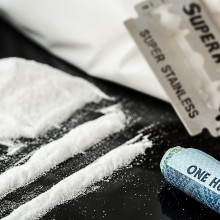
01:02 - Ketamine: dream depression drug?
Ketamine: dream depression drug?
with Professor Todd Gould from the University of Maryland
Around one in five people will have a severe episode of depression at some point  in their life, but the current drug-based treatments we have can take weeks or months to work - if they work at all. More than a decade ago, scientists discovered that the animal anaesthetic ketamine had a powerful anti-depressive effect, but the side effects - including loss of sensation, paralysis, hallucinations and out-of-body feelings - have limited its use. That might be about to change, thanks to research from Todd Gould and his team at the University of Maryland, Baltimore, as he explained to Kat Arney...
in their life, but the current drug-based treatments we have can take weeks or months to work - if they work at all. More than a decade ago, scientists discovered that the animal anaesthetic ketamine had a powerful anti-depressive effect, but the side effects - including loss of sensation, paralysis, hallucinations and out-of-body feelings - have limited its use. That might be about to change, thanks to research from Todd Gould and his team at the University of Maryland, Baltimore, as he explained to Kat Arney...
Todd - The presumed mechanism whereby ketamine resorts to antidepressant actions has always been assumed to be via the same mechanisms whereby it exerts its side effects, which is inhibition of a receptor for the neurotransmitter glutamate - the NMDA receptor.
Kat - These are like the little gates on nerve cells that send signals between cells, isn't it?
Todd - Exactly.
Kat - What was the question that you were trying to figure out with this research? Where did you take this idea next?
Todd - What our evidence suggests is that it's not ketamine itself that exerting the anti-depressant activities - it's a breakdown product or metabolite of ketamine. This metabolite does not inhibit the NMDA subtype of the glutamate receptor. It does enhance activity of another type of glutamate receptor which is the AMPA receptor. The precise mechanism whereby it does this is not clear to us yet. We also showed that if we give only the hydroxyzine norketamine, we observe similar antidepressant effects we observe when we give ketamine itself.
Kat - What would be the advantages of giving this breakdown product of ketamine rather than ketamine itself?
Todd - So, ketamine has a number of side-effects. Some of them are related to its use as a club drug. What we show with this metabolite is that, to the extent possible using our animal models, that we don't have any of those side-effects. So we go up to pretty high doses - 40 times the antidepressant effective dose and we don't see side-effects.
We also looked at the capacity of ketamine versus hydroxyzine norketamine to be self-administered.
Kat - So if the mice keep wanting to take it, it's like they're addicted to it?
Todd - Yes. So, basically, mice press a lever to receive an intravenous injection of the drug, and mice will readily press a lever to receive ketamine. With hydroxyzine norketamine, they can occur less.
Kat - When can we get hold of this drug - what's the next step for it?
Todd - So, moving forward, we have a reasonable amount of confidence that hydroxyzine norketamine is safe, and the reason is that it's been in humans now for many decades - as a byproduct of getting ketamine you have hydroxyzine norketamine. So we know in very general term that hydroxyzine norketamine is quite safe for humans, but we still have to go through all the necessary regulatory steps - toxicology studies in model animals to prove that before we can move on to human clinical trials.
Kat - Do you think that there are other similar drugs that might be useful that you need to investigate in this way?
Todd - As a protocol, I tend to think when you give a drug, that that's all you're giving. And this is an example that when you're giving a drug, you're also giving all the metabolites of that drug and the majority of drugs are metabolised. It's important to us and to me and I think to the field that we need to consider more vigorously that the biologically active molecule may not be the drug itself that we're giving.

04:37 - How to hide a top secret message
How to hide a top secret message
with Professor Mark Lorch, University of Hull
Scientists have demostrated how to hide a secret message using everyday  liquids, like cola, wine or coffee. Graihagh Jackson went undercover to meet Mark Lorch to find out more...
liquids, like cola, wine or coffee. Graihagh Jackson went undercover to meet Mark Lorch to find out more...
Mark - This group in Israel have come up with a way of encoding messages, and hiding messages, and then decoding them with common household liquids, so, it could be a glass of wine, or whatever. And so, that person that you've spotted over in that corner may well be that secret agent.
Graihagh - That's pretty awesome!
Mark - It is, isn't it. What they've done is they've taken a load of fluorescent molecules and combined them. Fluorescent molecules are basically molecules that absorb light of one wavelength and then emit it in another wavelength. Now the really cool thing about this molecule then is that the light it gives off is entirely dependent on the conditions it's in. If it's in coke, for example, it will give off a spectrum of light that's unique to the coke and, if you put it in a glass of wine, it will give off another spectrum of light, or a cup of coffee, another spectrum of light, and so on. So, using that, they've managed to come up with a way then of encrypting a message...
Graihagh - What I haven't told you Mark is that I'm actually as secret agent...
Mark - Oh are you!
Graihagh - ...And this interview - it's all a ruse so you can tell me how to decrypt secret message. So, say I want to send you message and we're going to make it really simple. I just want to say hello so Hi is the message we're going to send...
Mark - Just Hi. Okay that's... So the first thing we have to do is we have to turn the letter in 'Hi' into numbers. So, let's say we make 'H' 1 and we make 'I' 2 - okay. Then what we have to do is encrypt that. What we do now is we take some of this molecule and we put it into a solution - okay. This, again, could be your coke, or your wine, or whatever and you then measure the spectrum of light given off by that molecule when it's in coke, for example. And then you assign part of the spectrum to each of the letters - the 'H' and the 'I'. Let's say 500 nanometers, we assign that to 'H' and 520 nanometers, we assign that to 'I', and then we measure the amount of light at 500 nanometers and 520 nanometers, and that gives us a number. So the amount of light given off, we measure that in arbitrary units. Let's say 500 nanometers that corresponds to 'H', we get a value of 5, and 520 nanometers which corresponds to 'I', we get a value of 10. Now what we do is we add the 5 and the 10 to the 1 and the 2. So 5 plus 1 equals 6 and 10 plus 2 is 12.
Graihagh - So what I'd write down to you is 6 and 12?
Mark - Yes. So you'd send that, however you like. In a letter, in an email in a tweet, whatever, you'd send me 6 and 12. Now, all I have to do is take that same molecule, put in the same solution that you've used - the coke again, let's assume, and measure the spectrum. And then, again, I'll measure 500 nanometers and 520 nanometers and get the values of 5 and 10 back out, take that off the 5 and the 12 to get 1 and a 2. We already know that the 1 corresponds to 'H' and the 2 corresponds to an 'I' and, from that, I get my message.
Graihagh - So what I want to know is would spies actually is this or is this just a bit of a gimmick? Now that we've discussed it and everyone knows the secret...
Mark - Well, I did wonder about this because it was published in an open access journal, which makes you wonder...
Graihagh - No longer top secret...
Mark - No longer top secret but, just because you know how the system works, doesn't mean it isn't still secure. Nevertheless, I think it seems slightly strange.

09:51 - Myth: The cuddle chemical
Myth: The cuddle chemical
with Dr Kat Arney, Naked Scientists
This week, Kat Arney has been getting up close and personal with the so-called  "cuddle chemical".
"cuddle chemical".
Kat - It's been described as the 'hormone of love', and even 'nature's love glue' - a simple chemical that bonds mothers to their babies, is said to be responsible for keeping couples loved up, and has even been claimed to be able to make us all more generous, trustworthy and compassionate. We're talking about the molecule oxytocin, and there are research studies of varying size and quality showing that a lack of it might be to blame for problems such as alcohol or drug addiction, while a quick sniff of the stuff can keep men faithful, make you feel more sociable, and even help you lose weight.
But - sadly for anyone who's hoping that a simple squirt of oxytocin might be the solution to all their problems and help them snare the subject of their dreams - it's a bit more complicated than that.
Back in 2005, a trio of researchers published a paper in the journal Nature entitled "Oxytocin increases trust in humans", based on a small research study asking volunteers to play a game in which they had to trust each other, and were also given sniffs of the chemical. And while there's no doubt that oxytocin is a very interesting biological molecule, the full picture is more murky than moral.
Oxytocin is made in a part of the brain called the hypothalamus, and transported out across the whole body. Beyond doubt, we know that it plays important roles in birth, breastfeeding and parental bonding. And we also know that it's released in the brain and elsewhere in the body by non-pregnant people. But what's a bit more tricky to prove is exactly what it's doing, if and how it can change human behaviour, and whether it's acting alone or in concert with all the other chemicals and cues that feed into our thoughts, feelings and actions.
So what do we know?
Some of the strongest evidence for a role for oxytocin in romance doesn't come from humans at all, but from a certain species of prairie vole, Microtus ochrogaster, that pair bonds for life. And giving normally non-monogamous vole species doses of oxytocin and another so-called happy hormone, vasopression, switch them into monogamous behaviour. But, importantly, it's not enough just to dose voles with drugs to make them monogamous lovers - they need to spend time together too, at least six hours of hanging out together to feel bonded. But humans aren't voles, so what else do we know about how oxytocin might affect our brains and behaviours.
One small study of less than 100 participants, published in the Journal of Neuroscience, suggested that a sniff of oxytocin made men in long-term monogamous relationships keep a greater distance from an attractive woman (who wasn't their partner) than single ones.
Oxytocin has also been found to improve people's perception of their own personality, in turn making them more outgoing in social situations - again in a small study of in a small study of 100 people. It's been shown to counteract the feelings of drunkenness induced by alcohol and maybe even cut cravings for booze, and has also been shown to play a role in addiction. Furthermore, a preliminary report from a study of just 10 overweight or obese men reported at a meeting in April this year suggests that a sniff of oxytocin might help to improve their self-control around food.
It's certainly not all good news though. Giving people oxytocin can actually strengthen bad memories and increase anxiety, or make people oversensitive to the emotions of others.
Meanwhile a 2011 study with 280 Dutch volunteers showed that giving them oxytocin encouraged them to feel more negatively towards those perceived as outsiders, potentially encouraging racism, xenophobia and prejudice. It's also been linked with an increase in dishonesty in men, as well as other negatively-perceived feelings such as envy and schadenfreude. So much for the 'love chemical', if it only applies to loving people like you...
Another study showed that giving couples sniffs of oxytocin could help boost communication between them. It's clear that communication is key to good relationships, and even just talking with and touching each other can lead to oxytocin release in the brain. But can adding oxytocin jump-start the communication process and salvage a relationship on the skids? We don't know, because human love-lives are far trickier to unravel in the lab than simple cells or organisms.
There are also big differences between people that affect how they respond to oxytocin in different circumstances. Some of them are down to personality, others are genetic, and yet more come down to sex - men and women respond differently to the hormone.
Regardless of the conflicting scientific evidence, oxytocin's reputation as the love drug is problematic, because the reporting about its loved-up effects has now meant that it's possible to buy oxytocin on the internet, even though there's no good evidence that it's effective, safe for long-term use, or that it's even what it says on the bottle.
So what does oxytocin actually do, if it isn't fair to call it the 'love drug' or 'cuddle chemical'? And there's certainly no good evidence that giving people a whiff of oxytocin will make them fall in love, stop them from straying or make the world a better place - that's an awful lot to ask of a single molecule in the molecular maelstrom of our bodies and brains. It's probably safest just to say that it's a molecule that has an influence on our social interactions, but exactly how depends on who we are and our circumstances. And that's not something a quick squirt from a bottle of oxytocin can change, however much you want to believe the hormone hype.
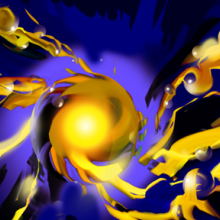
15:45 - Scientists build world's tiniest robot
Scientists build world's tiniest robot
with Professor Jeremy Baumberg, the University of Cambridge
Can you imagine a robot that's one hundred thousand times smaller than the  width of a human hair? Devices this small called nanobots sound like something out of science fiction, but researchers at the University of Cambridge have this week moved us one step closer to them being a reality with the hope that one day, they'll be use them in the body for drug delivery. Professor Jeremy Baumberg spoke to Emma Sackville about this exciting development...
width of a human hair? Devices this small called nanobots sound like something out of science fiction, but researchers at the University of Cambridge have this week moved us one step closer to them being a reality with the hope that one day, they'll be use them in the body for drug delivery. Professor Jeremy Baumberg spoke to Emma Sackville about this exciting development...
Jeremy - We've had this idea that you could make tiny machines - what people call nanobots that could actually go inside the body or they could do something useful for us and the problem has been we can't make them.
Emma - Why is it that we have problems making them?
Jeremy - When we try to make things move in water and they're very small, it's a bit like us trying to swim in treacle. It's very, very difficult so we need to actually swim in a different way. We can't do front crawl in treacle, we have to do something which is bit more like a bull terrier which flicks things backwards and forwards, and that's actually difficult to do and needs a lot of force, and we haven't found a way of actually making things that produce large force on this really small scale before.
Emma - But the research you've just done is actually looking at making something that moves on a really small scale and produce that kind of force.
Jeremy - Yes, we call them activating nano transducers, or ANTS for short, because they're strong things and they can move more than their body weight. So what we've done is we've made some tiny particles which have got a coating on them and what these particles do, under the right circumstances, is they can actually produce a really large kick.
And the way it works is we take tiny little particles, in this case we make them of gold, and we've learned to coat them with a thin polymer, a bit like the polymers in our plastic bags, but this ones and gel and most of the time, at room temperature, it likes to have little fibrils of the polymer which spread spread out into water. But, if you just heated a tiny amount, a few degrees, what happens is it starts to hate water - it becomes hydrophobic, unlike many of us with swimming pools, and this gel will collapse. So we have these metal nanoparticles and they want to stick together because they're trying to get away from the water, so they stick together really close. It's like a spring, they'll compress this polymer in between them. If they cool down very, very slightly, all of this reverses and now the polymer wants to spread out into the water but it's got to push apart the metal nanoparticles to be able to do that, so everything explodes. The nice thing is that we can do this heating and cooling with very weak beams of light and so we can actually make a little engine which is powered by a very small beam of light.
Emma - Great. Well, can I go and see some of them in action?
As Jeremy took me over the lab, I tried to mentally recap exactly how these ANTS worked. So we have tiny bits of gold, coated with a gel and below 30 degrees they like water and they really spread out. If we heat them up or shine a light on them, then they stop liking water and they all scrunch together just like a spring, as Jeremy said. PhD researcher Sean Cormier joined my in the lab to show me this change in action.
Sean - Some of the ANTS - a nice red colour and you just have to heat it up above 32 degrees.
Emma - Okay, so we've got like a little tiny capsule with a red liquid in and it's just in an oil bath at the moment so we're just heating it up, and what exactly are we looking for?
Sean - So what will happen is all the particles will actually change the way they interact with the water, and they'll change colour because they'll stop liking the water, and they'll collapse on top of each other, and now they're very purple.
Emma - Yes, okay. So the liquids actually changed from red to purple. It changed pretty quick! How fast have you been able to measure it changing?
Jeremy - In fact, it's too fast for us to measure at the moment and that's why it gives such a big force and, in fact, it's gone back to red. So what happens is all the ANTS cluster together - it goes purple, and as soon as it cools they explode. So that's how we keep track of it by looking at the colour.
Emma - It feels very weird to be in a lab without wearing lab specs, I must say!
Jeremy - It's very safe at the moment but you're right.
Emma - Despite the name, the gel Sean and Jeremy showed me really looked nothing like an ant. I asked Jeremy whether he had any specific ideas about how they could use the ANTS or whether there are any future applications.
Jeremy - So there's this area of science called microfluidics where you try and make little chemical refineries in some ways but shrunk down to the size of a chip, so that's the idea for one of the earliest applications. For applications where we put them in our body yes, indeed, we really don't know how to do that yet. One of the good things is we don't just have to use light to make these things open and close so it's actually a rather generic technology. Yes, we have to find out what's the killer application or maybe the non-killer application for the body!
Emma - And if we did want to use them for these kinds of applications, how easy is it to make them? Is the large scale synthesis of them feasible?
Jeremy - Yes, that's the amazing thing. All the components, as it turns out are completely commodity; we can buy them on a very large scale. So, in fact, already there's nothing stopping us scaling these up and making a kilogramme of these ANTS. We can replace the gold nanoparticles that we use at the moment with silver nanoparticles, which is cheaper, and we can use nickel or copper as well, that should be fine so making them is not the problem. The question is how to turn them into something useful and that's going to take us the next year. We want to make some of these demonstrators in the next but, of course, what we really want is a lot of other scientists to join us in this quest.
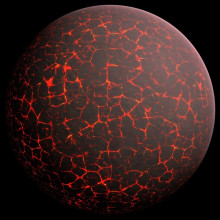
21:10 - Mercury's May Transit: Why do we care?
Mercury's May Transit: Why do we care?
with Dr David Rothery and Dr Carole Haswell, Open University
On Monday, Mercury passed between us and the Sun, blocking out some of its 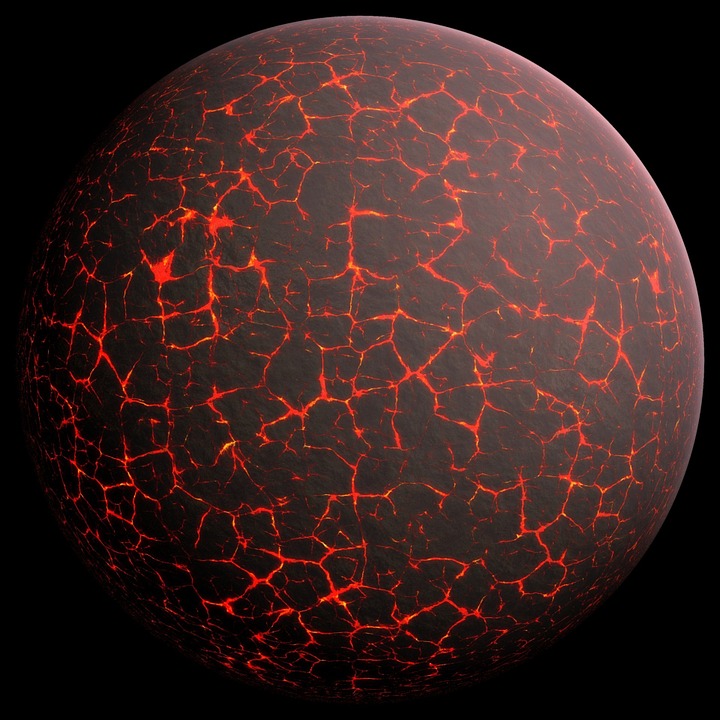 rays in an event that only happens every few years. David Rothery told Graihagh Jackson why these so-called transits are so important...
rays in an event that only happens every few years. David Rothery told Graihagh Jackson why these so-called transits are so important...
David - When it was first realised that planets would pass between the earth and the sun, it was important to look at transits because seeing the same transits from different points on the globe and getting the timings right helped you work out the scale of the solar system. The first transit observed was one of Mercury, in fact, early in the 17th century. Haley was the one credited with realising the trigonometric benefits of observing a transit from different places. He said "observe the same transit from two distant places on the earth, and you can use trigonometry to work out the relative difference between the earth to mercury and, therefore, from mercury to the sun and, therefore the earth/sun distance," which wasn't accurately known at the time.
Graihagh - And this is how the astronomical unit came about?
David - This is the definition of the astronomical unit which is the average distance of the earth from the sun.
Graihagh - And why is an astronomical unit important? I'm thinking if we ever wanted to go to Mars are we like - oh it's like five astronomical units? I always think of things in light years these days.
David - Cast yourself back to the 17th century. We did not know how big the solar system was. It was late in the 16th, early in the 17th Century when opinion was swinging away from the old view of the solar system which had everything going round the earth, to accepting what Copernicus has said "the suns in the in the middle, everything else goes round the sun." And once that was realised, it become important to work out how big is all this? So this was a step towards realising the scale of the universe, which is vast.
Graihagh - Transits like Mercury's have been used to form the very basis of our understanding of space but now that we've learned everything we can, are they just a pretty effect?
Well in our solar system - maybe. But, if we look further afield using a telescope, we can actually pick up the transits of other planets around other stars. These so-called exoplanets cause a dip in the light of the star they're orbiting and, through monitoring their progress, the things we can learn are incredible.
Dr Carole Haswell is an astronomer from the Open University...
Carole - In about, I think it was 2003, I saw the press release for a paper which had observed an exoplanet, using the Hubble space telescope, to look in the ultraviolet and they had seen instead of a 1% - a very subtle dip - a 15% diminishing in the light from the star when the planet passed in front of it from our point of view and this told us that the planet was actually surrounded by a huge cloud of hydrogen. And I just thought that was incredibly interesting that you could get such a prominent signal from something that is a planet that we can't directly detect. At that point I thought this is just too exciting and exoplanets are the way to go.
Graihagh - Before you mentioned that you were looking at the chemistry of what's in these atmospheres. You mention hydrogen - what other elements can you detect and, I suppose, what does that tell you about that planet?
Carole - The atmosphere of an exoplanet is, actually, generally quite a thin layer but, if you go further out, the planet is surrounded by a much more extended cloud, so the exosphere, the extended atmosphere of the planet. In the exosphere we've discovered all sorts of things including: iron, carbon, oxygen silicon. You name me a chemical and, whether or not we've discovered it, is likely to be a function more of whether we have been able to make measurements at the right region of the electromagnetic spectrum at the right wavelength of light.
Graihagh - What's the ultimate goal? Why study these exoplanets?
Carole - We need to understand our own environment and, particularly, what we're doing to our own environment. One of the ways we can get insight in that is to look at a wide variety of different planets so we can examine all the different bits of atmospheric physics in different parameter regimes. This allows us to actually, rather than just looking at this one example, get some empirical measured data that will allow us to properly train our analysis of the earth and be able to know that the models do seem to reproduce reality.
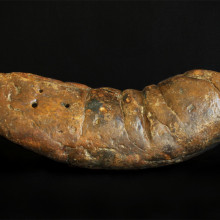
26:24 - The East Anglian gold rush for dino dung
The East Anglian gold rush for dino dung
with Dr Robert Evans, Anglia Ruskin University
If you've followed environmental stories over the years, you'll know this tune.  Scientists and environmentalist have long been singing off the same songbook when it comes looking after our planet - we take too much oil and gas out of the ground, we cut down too many trees and inject too much carbon dioxide into the atmosphere...
Scientists and environmentalist have long been singing off the same songbook when it comes looking after our planet - we take too much oil and gas out of the ground, we cut down too many trees and inject too much carbon dioxide into the atmosphere...
But drum not often banged is the dwindling supply of phosphorus. It's is an essential element for all life. It makes up our DNA and all organisms need it for energy. It cannot be replaced; there is no synthetic substitute: In other words, without phosphorus, there is no life. And so this week on the Naked Scientists, we investigate whether we're running out of phosphorus for fertliser. But first, Graihagh Jackson went on a field trip to the outskirts of Cambridge to find out how us Brits were once self-sufficient in phosphate production thanks to dinosaur dung! - And to ask Dr Robert Evans whether we could be once again...
Graihagh - Hi Bob.
Bob - I hope you haven't been here too long?
Graihagh - I have but I've been enjoying the sunshine. I didn't realise how long it would take to cycle.
Bob - Well, I've got a tremendous cold...
That's Dr Robert Evans from Anglia Ruskin's University and, despite his tremendous cold, he still let me pick his brains about phosphorus.
Robert - Oh phosphorus. P, phosphite. It's an element that most plants need to grow. It's part of proteins, it's part of your body, it's part of plants. Most soils in Europe, and I think probably worldwide, are short of phosphite so it's a key ingredient for plant growth. So if you want to improve yields, you've got to put these kind of things on.
Graihagh - I've read all sorts of weird sources of phosphate. Things like blood and bones and all sorts of things.
Robert - Yes, that's right. When phosphate fertilizers were first devised, it was mainly using rock phosphate and then when we had the phosphate nodules here, the dinosaur poo, it was obviously much cheaper doing it here.
Graihagh - What was this dinosaur poo? How was it formed?
Robert - Cambridge Greensand was forming over about 100 million years ago and, whether it's really dinosaur poo or whether it just looks like dinosaur poo, I think there's quite a bit of argument about that.
Now then, we are literally about there. That's Coton, the village there.
Graihagh - These instead of ordnance survey's they're like geology surveys?
Robert - The geology maps and these, in places, are almost identical but the geology maps we're looking at the rock depth. We were looking at it in the top 1.2 - 1.5 metres. So, if you look on here, Cambridge Greensand is literally in Cambridge - that's it. 92a.
Graihagh - This is sort of a light blue colour we're looking at and you're right, it is a very thin stretch that goes from sort of Southwest Cambridge all way through North/Northeast Cambridge. But, what I notice is, all of Cambridge urban area is also in this light blue colour.
Robert - That's because it's urban. Nine on this map means disturbed ground so it's a very similar colour to urban.
Graihagh - So it's not that Cambridge is sitting on a huge supply of....
Robert - It is actually. There's probably quite a lot of it. In places it was really widely excavated and there's quite a lot of - I think the outskirts of Cambridge was excavated for the coprolite diggings.
Graihagh - And on the outskirts of Cambridge is Coton where one of the many excavations of coprolite took place. We wandered over to an adjacent field to a rather underwhelming plaque...
This is a tiny sign...
Robert - You have to get down on your hands and knees to read it. It's not very spectacular but I was absolutely gobsmacked when I saw it.
Graihagh - Gobsmacked because this sign represents a significant part of history - The East Anglian Goldrush.
So coprolite is the commercial name for phosphatic nodules which were formed in the rock under your feet, deposited around 110 million years ago. When experiments showed locally mined coprolite could be turned into fertilizer much more cheaply than imported bone meal, the great coprolite rush of the 1850s was on. And there's a picture as well actually of the diggings near Orwell and Barrington.
Robert - The industry grew and landowners, and tenants, and agricultural workers alike could make money from the new industry. It's just amazing how quickly the labour market expanded.
Graihagh - Something like Barrington, it said before the coprolite industry there was no-one living there. During the industry there was 155 and then afterwards there were 3. So, actually, Barrington was born because of coprolite?
Robert - Yes. It says in the peak, 1877, Cambridgeshire produced almost all of the 54,000 tons of raw phosphate used for manufacture in Britain. So, in actual fact, we were self-sufficient in fertilizer. That was absolutely gobsmacking!
Graihagh - Given today that we're not self-sufficient at all.
Robert - In practically anything! The industry waned in the 1880s as cheaper phosphate was imported from North America and today, most of the coprolite diggings like this one are filled in and the land returned to agricultural use.
Graihagh - Does that mean we can be self-sufficient again?
Robert - No - it's all been dug out.
Graihagh - All of it?
Robert - Well it's something like 40 out of thousands of acres that's left. So there's probably no more coprolite diggings to be done.
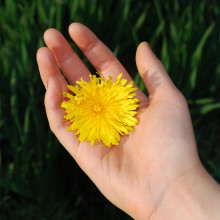
32:05 - The phosphorus famine
The phosphorus famine
with Dr James Dyke, University of Southampton
You need phosphorus to live and we're running out. When will we start to see  supplies dwindle and is there anything we can do? Dr James Dyke is the co-chair of Sustainability Science Southampton explained to Kat Arney the predicament we face...
supplies dwindle and is there anything we can do? Dr James Dyke is the co-chair of Sustainability Science Southampton explained to Kat Arney the predicament we face...
James - Well, the vast majority of phosphorus comes from phosphate rocks. So phosphorus is not a particularly rare element in the earth's crust . About 1% of the earth's crust is comprised of phosphorus, so that translates to something like 1,000 billion, billion tons of phosphorus. So there's a lot of phosphorus around. Unfortunately, there are not a lot of high concentration deposits of phosphorus and it's those high concentrations deposits that thus far we've entirely relied on to power our agricultural system.
Kat - So to just draw a parallel with something like oil. Are there particular places in the world that are the phosphate capitals of the world where this stuff can be mined?
James - There are, and there's actually many fewer places so, in terms of the good quality phosphate deposit, you're looking at China, the United States, Morocco and a couple of other countries that have about 85% of the entire reserves of phosphorus. In Morocco and the Western Sahara alone, you're looking at about 75% of all the known high quality phosphorus reserves.
Kat - That to me seems kind of risky. It's always risky when you hear about an essential resource that is concentrated just in one or two places in the world.
James - It might be, mighten it? You might think that certain wars have been fought over getting hold of oil. We've seen armed conflicts for water. So one of the concerns is when we see these high concentration deposits that begin to be depleted, we could be looking at just a handful of countries largely controlling the world's supply of phosphorus.
Kat - Bring on the phosphorus wars... NOT! Again, to draw another parallel with oil, there's been a lot of discussion about peak oil - have we reached that? How many fossil fuels are left in the ground? Where are we in terms of phosphorus, of phosphate that's left?
James - Ah well, that is the 6 million dollar question, isn't it? So it will depend widely on who you ask. If you talk to the International Fertilizer Development Centre, it thinks we will not see any constraints on phosphorus supply for a matter of centuries, maybe up to 300 years. If you were to go and look at the United States Geological Survey figures from just a few years ago, they will be giving peak phosphorus, so the maximum rate of phosphorus and thereafter the amount that we produce is going to get smaller every year, they're going to put that at as little as 2030. So, in as little as a few decades we could see a continual and progressive decline in our ability to extract phosphorus from rocks.
Kat - In that case, if that scenario is actually the one that's correct, this is actually quite an urgent problem but then, what happens to it. It's made into fertilizer, it goes onto the fields. Then what happens - why do we lose it out of the cycle?
James - Yes, you would think that given that it's actually crucial for all human life, at least, and all life on the surface biosphere we'd be a bit more careful with it. But when you look at how much we waste, it's an extraordinary amount. It's about 80% of the phosphorus that's initially used, initially dug out of the ground, is wasted before a human actually consumes it. So there are many points at which it's wasted; it's wasted initially when it's dug up and processed, there are losses there. There are losses when we put it on the field; soil erosion it gets blow away by the wind, it gets washed away by water. Then when we grow the crops there's significant amounts of food that's lost globally. So about 30% of global food produced is lost before it gets to market and then, when it's bought it in developed nations, we waste a lot of food because we buy too much food and then we throw that food away.
At each point on that process we are losing those phosphorus elements. I mean, we can't ever run out of phosphorus, it doesn't leave the earth but we're continually diluting that easy to get, high concentration deposits.
Kat - And in terms of the stuff that we put on the fields that gets leeched away or lost, where does that end up?
James - Well, unfortunately, for many habitats it ends up in water courses. In certain countries, particular regions of China let's say, there's a large amount of input of phosphorus fertilizer on the lands. Unfortunately, soil management is quite poor, large amounts of soil end up in the water laden with phosphorus, it runs down through rivers into lakes and there it produces eutrophication events. It promotes so much algae, the algae clog up the surface of the lake, they fall down to the bottom, they produce these low oxygen situations which rapidly kill all the large plants and fish. They go from nice productive aquatic environments that can produce fish for human as well as other wildlife to these rather unpleasant green, stinking lakes which can stay in that state for a very, very long time after the input of phosphorus is stopped. So it's a real ecological problem.
Kat - So how should we be viewing phosphorus if it can cause this eutrophication? Is it a pollutant, is it a finite resource, is it precious? How should we be viewing it?
James - Well it's both. It's absolutely crucial for life but it's also an incredibly damaging pollutant that we put into our water courses so, it's a finite resource in the sense of the high concentration deposits. There should be enough that would last us, but we need to do a much better job in managing the reserves that we have, and then also making sure that we don't lose so much and then end up using it, essentially, as a pollutant.
Kat - What can we do to lessen this problem?
James - Well, thus far we've looked at it as a supply site problem. So, the increase in phosphorus, when you look back over time, it's undergone this kind of exponential increase since the second world war but really, ultimately, what we need to be doing is taking some more inspirations from the biosphere. Phosphorus is a limiting nutrient for all life on earth and the biosphere's figured out how to recycle phosphorus so it's ultimately going to be reducing the losses from the system. So that's more recycling, more careful application, and much less amount of food that we're going to waste.

38:24 - Getting to the root of the shortage
Getting to the root of the shortage
with Dr John Hammond, University of Reading
Phosphorus is needed for crops to grow, so could we breed plants that don't need it? Or use bactieria to unlock more from the soil? Dr John Hammond talked through the possibilities with Graihagh Jackson...
it? Or use bactieria to unlock more from the soil? Dr John Hammond talked through the possibilities with Graihagh Jackson...
Graihagh - Surely the first plan of action should be to reduce the amount of phosphorus we use in the first place - right?
John - Yes, that's right. Phosphorus is essential for growing our food so can't do away with it completely. We have to have some inputs into the system and, as we've already heard to the second world war, the amount of phosphorus we were using has increased probably more than it should have done but we are on the case now and looking at that. And certainly in the UK over the last 20 or 30 years, the amount of phosphorus going into our fields has roughly halved.
Graihagh - But that's not enough then? I mean what else should we be doing or can we be doing?
John - Well, there are a number of things that we can look at. There are land management issues looking at creating a healthy soil so the phosphorus in there is turned over. Looking at alternative fertilizers and sources of phosphorus from things like sewage or we can look at breeding crops which are better at capturing the phosphorus in the soil and using it more efficiently.
Graihagh - Because I suppose there are places in the world like Australia, I'm thinking, where it's really poor in phosphorus. So there are plants that grow there so can we just steal some of their tricks of the trade and use them in our crops in the UK.
John - Yes, that's one of the types of things we're looking at doing. So, these plants in Australia live on very little phosphorus and yet they're able to produce large amounts of biomass. They have a number of attributes in their root systems and in their leaves that allow them to capture phosphorus more efficiently by exuding acids and enzymes into the soil to extract the phosphorus. Making very good, close relationships with thing like bacteria and fungi in the soil to help them capture the phosphorus and very extensive root systems that can mine the phosphorus from the soil.
Graihagh - And these bits of research you were mentioning there. Have they been successful? Have we been able to breed them into other crop varieties?
John - There's been a number of attempts to do these things. There's a couple of examples. For example, in China, there's some soya beans that are now available commercially where they've over-expressed in the roots some of these enzymes which are released from the root into the soil, and these enzymes can break down some of the phosphorus locked away in organic compounds. They are more efficient at capturing that phosphorus and producing higher yields for less phosphorus input.
And another example is in beans, where we've got this phenotype or characteristic of the root system where they are able to put a lot of their roots in the topsoil. Because phosphorus is very reactive, it doesn't move very far in the soil, it tends to stay in the top 30cms. So, if you can get a plant to put a lot of it's roots into that area of the soil, it can capture more phosphorus.
Graihagh - Is that not a bit of a risky thing to do though? I'm thinking if there's a drought or anything you want deep roots so, I mean, you can't really put all your eggs in one basket, surely?
John - No, no, that's it. So that is one of the downsides to that approach is if you put all your roots in the topsoil, you're at risk of maybe not being able to capture maybe water and nitrogen which are further down in the soil profile. So there has to be some aspect of plasticity in the root system that allows the plant so respond to an appropriate stress,.
Graihagh - And you mentioned this sort of inaccessible phosphorus in the soil before and how these root system produce enzymes to get this phosphorus out. I wondered if you could just sort of unpick that a little bit for me?
John - Well, a plant can only take up phosphate which is in the soil solution and the rest of the phosphorus in the soil is either bound to the soil particles through very strong bonds or in organic compounds, so dead plant material or dead microbes. But, in the soil, there are fungi and bacteria which have to scavenge that phosphorus as well from those sources, and they have these enzymes and ability to release acids into the soil to release that phosphorus from it. So plants, historically, are very good at making mycorrhizal symbioses, which help the mycorrhizal fungi catch the phosphorus for the plant and, in exchange, the plant gives the fungi some carbon so the plant can encourage those microbes to grow and help scavenge the phosphorus for them.
Graihagh - I imagine though trying to unpick what microbes are doing that job is next to impossible. There are thousands, if not millions of species of microbes in soil so, how do you go about finding the right one?
John - It is very tricky and up until probably the last five or ten years, it's been nye on impossible because a lot of the microbes in the soil won't grow very well in the lab. So it's very difficult to take them out of the soil and find out what's there.
With the advent of new sequencing technology, we've been able to take the DNA out of the soil and sequence that DNA, and start looking and identifying all the microbes that are there. We are actually part of a new BBSRC funded project where we're looking at, not extracting the DNA, but actually extracting the protein and sequencing the proteins that are in the soil around the roots, so that we can identify the types of enzymes that are active in the phosphorus cycling process, but also the microbes that those enzymes came from in the first place.
Graihagh - So you can sort of match them together and then, hopefully, design some microbial soil magic dust that you can sprinkle on and get your plants to extract phosphorous magically?
John - That's the idea.
Graihagh - I just have a bone to pick with you because, surely, you're kicking the can further down the road for future generations to pick up though because we're still reliant on this phosphorus despite reducing it?
John - Certainly. There's no way we can produce food without that so it's still a question of minimizing the amount we actually use, and using it as efficiently as possible in the farming system. But we do need to look at a whole host of mechanisms to close that phosphorus loop so we're not losing it to the water where it's causing eutrophication, and bring it back onto the farm so we're not washing it all away.
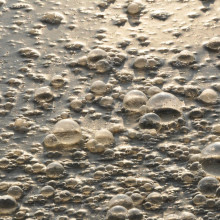
44:27 - Sewage: the answer to our prayers?
Sewage: the answer to our prayers?
with Pete Vale, Severn Trent Water
When we flush the toilet, we are disgarding a valuable source of phosphorus. Could we use our poo as fertilister? Pete Vale from Severn Trent water thinks so, as he explained to Graihagh Jackson...
Graihagh - Just over 15 years ago, a professor of civil engineering in the US, Don Mavernick, was trying to find a way to get rid of a pesky white mineral that clogged pipes in sewage treatment facilities. This pesky white mineral was struvite, a combination of magnesium, ammonia and, yes, you guessed it - phosphate. He thought, "well, what if we could choose where this struvite formed, i.e. not in pipes but in a convenient collection pot? Then we could stop pipes being blocked and sell this struvite as fertiliser - win, win!" But, somehow, the idea of soiling my sorrel with a derivative of human excrement seems unpalatable at best, abhorrent at worst. Before we make any judgments though, let's see how you get from poop to plantpot at Severn Trent Water...
Pete - There's three main stages to sewage treatment. The preliminary treatment stage where we take out core solids and that's what you can see over in that corner - the big steel structure. Then we have the primary treatment where we settle out the settleable solids - the faecal matter. It might sound quite unpleasant but it's actually full of energy and it's a really useful resource for us because we take that sludge and we digest it in anaerobic digesters, which are those huge concrete covered tanks that you can see a couple of hundred yards away.
Graihagh - And those concrete tanks were massive!
Pete - They are very big tanks. There's an awful lot of sludge in those tanks.
Graihagh - Like five stories high full of sludgy, sludgy, poo. All cooped up in an oxygen free, or anaerobic tank.
Pete - Anaerobic bacteria break down the organic content in the sludge and produce methane, and that methane we take and burn in a gas engine. The gas engine produces electricity, which we can then use on site, and export to the grid, and heat. And the heat we recycle back to the anaerobic digesters to keep them warm because they like to operate between 35 and 40oC.
Graihagh - And after this 15 days, what happens to all that sludge in there?
Pete - The sludge then is stabalised, so that means all the pathogens in it have been killed. We then dewater the sludge, so we use Stoke Bardolph centrifuges. So we wizz the sludge around to form what we call a "sludge cake."
Graihagh - This delicious sounding sludge cake is one of the end products of all our poo. It's the mother of all confectionery in the plant world, plied with important ingredients needed for life, and who wouldn't want to see that...
That's the sound of a fresh sludge cake dropping out of the centrifuges and, on closer inspection... Oh it's steaming! It's steaming! It's very um... yes they're basically like mountains of black steaming soil but this is really good for crops, really nutritious, rich in, I guess, phosphorous but also other nutrients as well?
Pete - That's right. So rich in nitrogen and rich in phosphorous.
Graihagh - Now, remember how the centrifuge syphons off the liquid from the solid sludge cake. Well this liquid is called "the liquor" and it's extremely rich in phosphorous. But Pete still needs to make it into struvite - this white mineral, so it can easily be sold and transported as fertilizer...
So, we left the sludge cakes in search of the phosphorus recovery plant. A big concrete barn decorated with numerous coloured pipes...
Pete - We've taken the sludge liquor that's come from the centrifuges and we're dosing in some magnesium to get the struvite to form. And the other thing that helps the struvite form is to raise the ph a little bit so, by blowing a bit of air into the tank, you strip carbon dioxide out, which raises the ph a bit and then the struvite forms crystals. What happens to this is it's sold to a fertiliser blender, who makes a liquid suspension fertiliser out of it. So they add in nitrogen and potassium to make a balanced fertiliser.
Graihagh - And if every sewage plant in the country was making this struvite, how much could we make? I mean, would it be enough to cover the sort of stuff that we're importing at the moment?
Pete - It's a bit hard to calculate but, as a rough guide, I think if we were able to recover all the phosphorus from sewage, and that's not an easy ask I have to admit, but it would account for about 50% of the total mass of phosphate we import into the country. So, a significant contribution.
Graihagh - But is it commercially viable - what's the sort of price range of this sort of stuff versus the stuff we're importing from rock phosphates, for instance?
Pete - A very interesting question and, at this stage, the revenue we get from the struvite offsets the cost to make it but doesn't provide much revenue. Now that may well change over time as phosphate rock reserves are beginning to deplete, so the likelihood is phosphate rock prices will rise.
Graihagh - I mean, values one thing, but I think the perception of turning what is essentially sewage into something that we then put on our crops and use to grow and then eat again, is somehow - I know it's treated - but it's somehow unpalatable. I mean, would you be comfortable eating crops from this?
Pete - Absolutely! It's a purer form of phosphate than mined phosphate rock. It doesn't have contaminates that phosphate rock has that can be fairly high in cadmium and all sorts of things.
Graihagh - So, whilst sewage is seen as - well sewage, today actually this will be a resource. This is something that you could actually marketably sel. I mean, there's something quite amazing about that.
Pete - Yes, absolutely right! I think that's very much the future of sewage treatment because there's an awful lot of useful stuff in sewage.

51:28 - The perfect storm
The perfect storm
with Dr John Hammond, University of Reading and Dr James Dyke, University of Southampton
In 2050, we'll hit 'peak phosphorus' just when our population is at its highest and  demand for food will be high. What can you do as an individual to reduce your phosphorus footprint? Kat Arney put this to Dr John Hammond and Dr James Dyke...
demand for food will be high. What can you do as an individual to reduce your phosphorus footprint? Kat Arney put this to Dr John Hammond and Dr James Dyke...
Kat - It's not all doom and gloom then, there are things we can do to close the loop and lessen the load of the loss of phosphorus but is it going to be enough? James Dyke and John Hammond are still with us. John what do you think because I guess we're facing a growing global population, we've got issues of climate change and now, as has become clear, problems of water shortage potentially, and a phosphorus shortage. This sounds like a doomsday scenario?
John - Yes, I think there is sort of a perfect storm scenario that we could envisage coming up in the future where we've got all these competing interests coming together - population, food supply, climate change. But there are things that we can do, and we are doing, to try and mitigate that but there's no single silver bullet. It's a whole host of things, I think, we need to do.
Kat - So what can we do? Say me as an individual, I can do things to reduce my carbon footprint, I can cycle, I can try not to take so many flights - what can I do for phosphorus footprint?
John - Well, there's a couple of things. Firstly is reducing our meat consumption. Producing meat uses far more phosphorus than it does producing vegetables and grains. Going for a more vegetarian based diet would certain reduce it and research suggests, if we all went vegetarian, we'd probably reduce the amount of phosphorus we're using in our food production systems by 25 to 45%.
Kat - And James - what about reducing things like food waste? Are there other things we can do as a whole society?
James - Indeed, yes. So, in a developed nation context we do throw away tremendous amounts of food so that is throwing away a tremendous amount of phosphorus. In developing nations, the main problem they've got is getting the food from the field to the market before it rots. One kind of optimistic slant on this is, given how prodigiously wasteful the food production system is on earth, there's an awful lot of fat to cut, so there's an awful lot of savings we can make.
Kat - It just seems all round if we can do things to reduce our consumption of water, of fossil fuels to release less carbon, and use less phosphorus. This is generally all round a good thing so generally reducing consumption is what humans should be aiming to do on a personal and society level?
James - Yes, but if you look around that's not the kind of message that you tend to get on a day to day basis. We are continually compelled to consume more. So, by the middle of this century when there'll be the greatest number of mouths to feed - there'll be 9 billion people - we're going to have to produce 50% more food, gain access to 50% more water, generate 50% more energy, all at the same time as reducing our impacts on the earth's climate. And that may, unfortunately, be around the same time we could see a peak in our supply of phosphorus so, whilst there are lots of things we know we have to do, there's lots of things we can do individually, society, commercial and governmental contexts. This really is a very significant challenge that I think it's fair to say we're not really addressing right now.
Kat - But, presumably, every little will help.
James - Absolutely - do your part!
Kat - I think I shall try and have more meat free days - that's what I'm going to commit to.
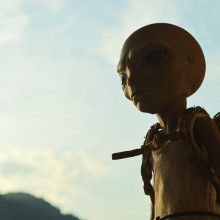
54:37 - Would we be able to detect an alien message if we got one?
Would we be able to detect an alien message if we got one?
Emma Sackville put this question to Dr Duncan Forgan at the University of St Andrews...
Duncan - If we received an encrypted message from space, it depends on how good the encryption is. If a message is very well encrypted, we wouldn't be able to understand it as an artificial message - it would look just like noise. Just like the kind of noise you see in the cosmic microwave background or the noise you see on your old fashioned television set.
If the encryptions not quite as good then there are certain things we can do to understand the quality of communication. We do this with communication from animals. For example, we can give it a rating to say how much information is contained in the signal and so we could certainly say this is very informative. But what the information actually is, is going to be very challenging to figure out.
Emma - Have we ever had anything similar in the past that could have been a message that people were excited about?
Duncan - The one that everyone remembers is what's called the "wow signal," which came in , I think, the early 70s, and it was a very strong, narrow band transmission being sent to the Earth. We think now that it was a natural signal; it was actually something bouncing off something else, but that signal had no information in it, it was just a pulse. But then even if the signals just a pulse, that still tells you something because a single pulse is basically "hello."
Emma - Ooh, that could be interesting. Okay - ultimate question. If we got a message, and if we could understand it, do you think we should respond to it?
Duncan - Well, the issue is we don't have a legal framework for figuring out what to do next. We have what's called the reply protocols that SETI scientists wrote down saying well, this is what we should do, but not-ones going to follow those protocols because they're not in international law. So, if a message was received and say, for example, America wanted to respond but China didn't - tough - America could still send the message on behalf of all of Earth, which is not great.
My personal opinion is that we shouldn't send any replies because, speaking as a human being, I'm not particularly impressed with how well human civilization copes with its responsibilities as a steward of the Earth. A little bit of time maybe before we become more respectable as a galactic civilization.
- Previous Check your compatibility
- Next Have you been mis-sold time?










Comments
Add a comment